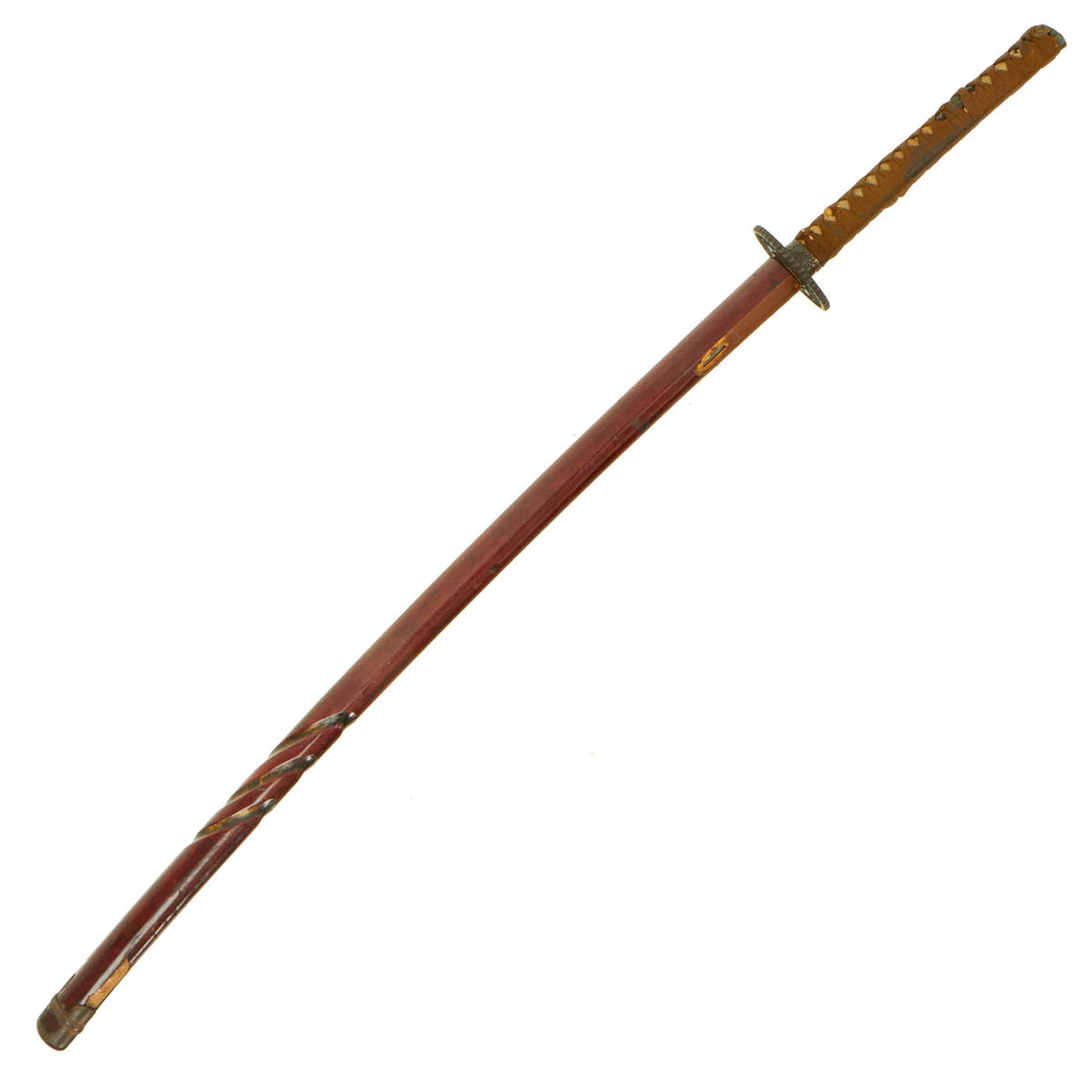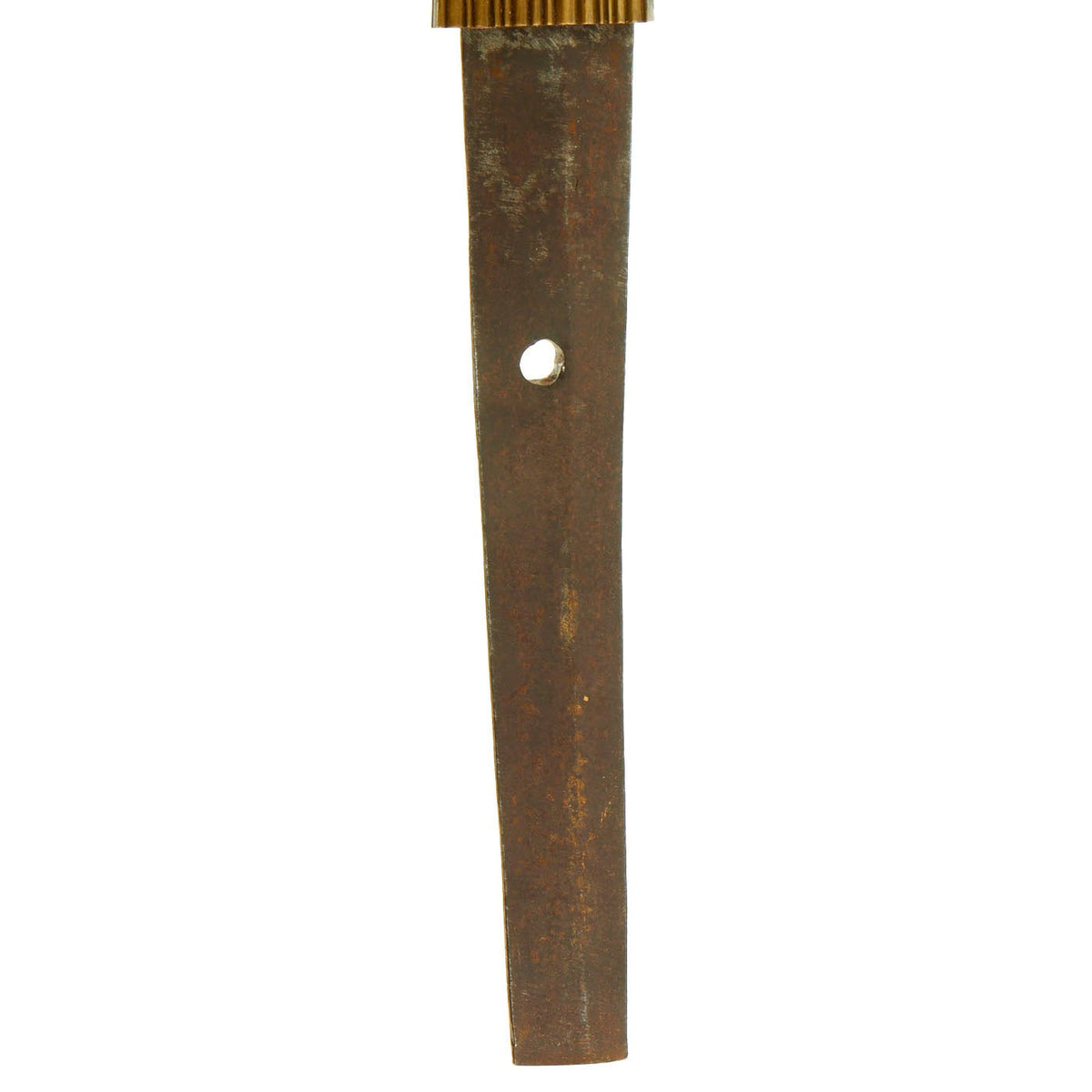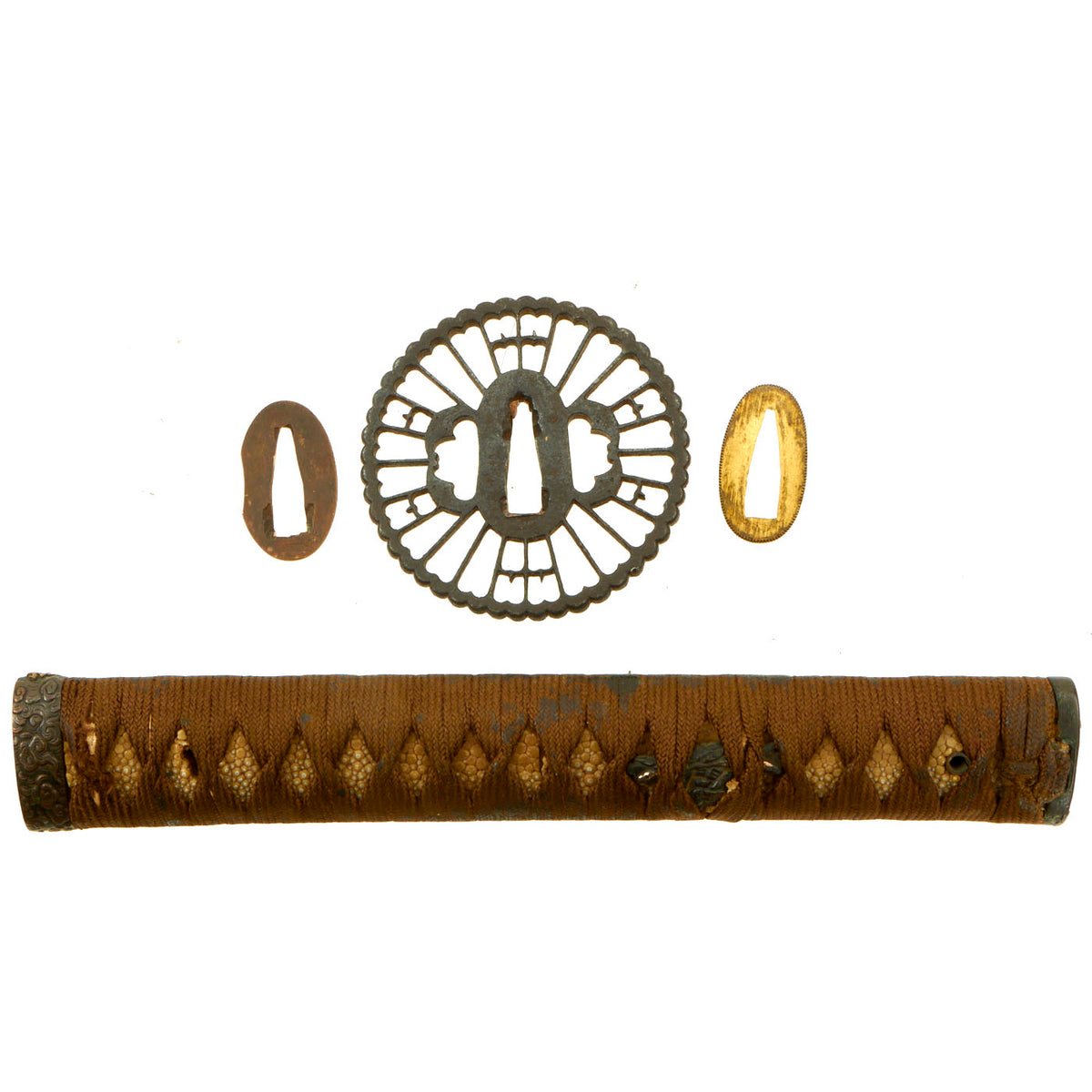Original Early 17th Century Japanese Handmade Katana Sword with Lacquered Scabbard – Edo Period Original Items
$ 2.495,00 $ 623,75
Original Item: Only One Available. The Japanese Katana (刀 or かたな) is a sword characterized by a curved, single-edged blade with a circular or squared guard and long grip to accommodate two hands. The design is iconic, and probably one of the best known sword styles in the world, easily identifiable even in silhouette. The official term for katana in Japan is uchigatana (打刀) and the term katana (刀) often refers to single-edged swords from around the world. Developed later than the tachi, it was used by samurai in feudal Japan and worn with the edge facing upward.
After the Meiji Restoration, its used became much less widespread, however when Imperial Japan developed large ambitions, the Katana once again returned as a sign of prestige and rank. After the war, many were brought home by returning U.S. servicemen, which how most that we see ended up in the United States.
This example dates from the early Edo period (江戸時代, Edo jidai) or Tokugawa period (徳川時代, Tokugawa jidai) of Japanese history. This is the period between 1603 and 1867, when Japan was under the rule of the Tokugawa shogunate and the country’s 300 regional daimyo. It is around the middle of the blade length range, and has a “Shinogi Zukuri” shape, the standard for the Katana.
This example has most likely been remounted several times, as was common for Japanese blades. This has made the file marks (yasurimi) on the tang faint, and given it a lovely patina. As there is no maker name on the tang, this blade is considered 無名 (mumei), or “anonymous”.
The blade has the following period correct features:
– Folded steel blade (fold lines are evident on the spine and body of the blade)
– hole (mekugi-ana) in the tang is punched and not drilled
– blade has a temper line (hamon), which is visible in various areas.
– blade shows grain (hada) in the body (ji), only possible with laminated steel.
– Blade wounds (kizu) or lamination artifacts are present on the blade. Both ware (lamination lines) and fukure (carbon pits) are visible.
The blade of this example is 28 3/8 inches long, and the polish on the blade is unfortunately degraded, with some small areas of light oxidation and staining. This has made seeing aspects of the blade difficult, and it has definitely been some time since the last time it was fully polished. The edge does not have any major nicks or dents, and is still relatively sharp, so care should be taken. The tang (nakago) is of the futsu 普通 (regular) style, with a KIRI (cut) nakago-jiri (tang tip). It does not however look to have been cut down, so that may be how it was originally cut after forging.
The hamon (temper line) is still visible in the light throughout the glade, and is a very attractive GUNOME MIDARE (Irregular Zig Zag) shape. It actually looks like the 三盆杉 Sanbonsugi – Three Cedars shape with spaces between. Along the transition there are clear NIE crystals visible, with cloudy areas of NIOI in the body of the hamon, and some nice activity. The YOKOTE is still very faintly visible, as is the BOSHI (tip temper line), which is a OMARU (large turnback) type. The body of the blade (JI) shows hada (grain), which is of the MASAME (straight) type. There are blade wounds including ware (lamination splits) and fukure (Carbon pits) confirming that it is a traditionally handmade blade.
The tsuba (cross guard) is made of iron and is of the Maru Gata (round) shape, and is highly perforated with a ribbed outercircumference. There are two Hitsu-Ana accessory cutouts in the tsuba for the kogai (hair ornament) and kogatana (companion knife”, though there are none included. There are two seppa (spacers) around the tsuba. The fuchi (collar) for the tsuka (handle) is embossed bronze, and looks to be a “cloud” design, and there is a bronze Kashira (End Cap) on the bottom, which has some embossed and gilt designs. There are two bronze menuki grip ornaments present, which are an intricate design that we cannot identify. The stingray (Sa-Me) grip is in very good condition, and the brown grip wrapping (Ito) shows light wear and staining, so it was most likely re-wrapped in the late 19th century, and possibly other times.
The sword comes in a a well fitting wooden scabbard (saya), which has a very attractive red speckled black lacquer paint job. There are also three angled grooves in the body, which are gold highlighted, and a very nice iron end fitting (sayajiri), which shows oxidation. The scabbard is in very good condition, and definitely looks to be of great age. There is some splitting along the seams, and the lacquer has chipped away in those areas. The kurikata (knob) where a cord might be attached is missing, and it looks like there was a one time a koiguchi (scabbard mouth) fitting, which is now missing.
A nice Early Edo Period Katana, complete with scabbard and ready to display!
Specifications:
Blade Length: 28 3/8″
Blade Shape: Shinogi Zukuri
Overall length: 39“
Scabbard Length: 30″
It has been over one thousand years ago that the art of making swords appeared in Japan. The swordsmiths of the time may not have known it but they were creating a legendary sword. The Samurai sword has seen combat in many battlefields. From the early days of the Samurai warrior to the fierce battles in the South Pacific during WWII.
Each hand-made Japanese blade (日本刀 – Nihonto) is unique because it is forged from multiple pieces of folded steel stock. A tremendous amount of work is dedicated to creating these pieces. They were an instrument of war as much as a beautiful artifact to adorn a room.
The traditional Japanese blade and mountings have grown to be one of the most highly desired military antiques.
Fast Shipping with Professional Packaging
Thanks to our longstanding association with UPS FedEx DHL, and other major international carriers, we are able to provide a range of shipping options. Our warehouse staff is expertly trained and will wrap your products according to our exact and precise specifications. Prior to shipping, your goods will be thoroughly examined and securely secured. We ship to thousands clients each day across multiple countries. This shows how we're dedicated to be the largest retailer on the internet. Warehouses and distribution centres can be located throughout Europe as well as the USA.
Note: Orders with more than one item will be assigned a processing date depending on the item.
Before shipping before shipping, we'll conduct a thorough inspection of the items you have ordered. Today, the majority of orders will be delivered within 48 hours. The delivery time will be between 3-7 days.
Returns
The stock is dynamic and we cannot completely manage it because multiple stakeholders are involved, including our factory and warehouse. So the actual stock may alter at any time. It's possible that you may not receive your order once the order has been made.
Our policy is valid for a period of 30 days. If you don't receive the product within 30 days, we are not able to issue a refund or an exchange.
You can only return an item if it is unused and in the same state as the day you received it. You must have the item in its original packaging.
Related products
Uncategorized
Uncategorized
Uncategorized
Armored Burgonet Helmet & Polearm from Scottish Castle Leith Hall Circa 1700 Original Items
Uncategorized
Uncategorized
Uncategorized
Uncategorized
Angolan Rebel 1970s era 60mm Inert Display Mortar from Angolan Civil War Original Items
Uncategorized
Uncategorized
Australian WWII Owen MK1 Machine Carbine SMG Custom Fabricated Replica with Sling Original Items
Uncategorized
Uncategorized
Armoured Fighting Vehicles of the World: AFVs of World War One (Hardcover Book) New Made Items
Uncategorized
Uncategorized
Uncategorized
Uncategorized
Uncategorized
Uncategorized
Uncategorized
Uncategorized












































































